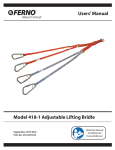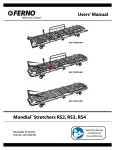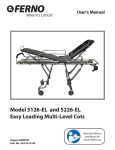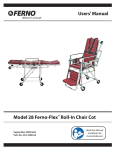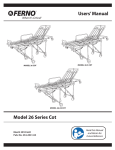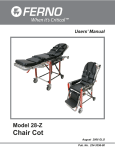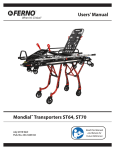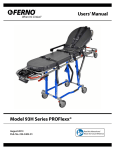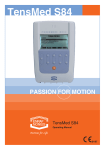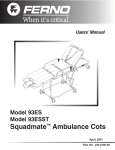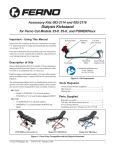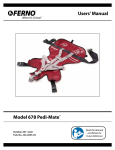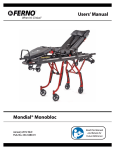Download FERNO® - Ferno Norden
Transcript
FERNO ® When It’s Critical ® Users’ Manual RS2 Stretcher RS3 Stretcher RS4 Stretcher Mondial® Stretchers RS2, RS3, RS4 January 2011 GLO Pub. No. 234-3450-04 Read this Manual and Retain for Future Reference Mondial® Stretchers Ferno Technical Support Customer service and product support are important aspects of each Ferno product. Please have the product serial number available when calling, and include it in all written communications. For technical support questions, please contact your Ferno distributor. Ferno Customer Relations For ordering assistance or general information: Serial Number Canada and the U.S.A. Telephone (Toll-free) 1.877.733.0911 Telephone 1.937.382.1451 Fax (Toll-free) 1.888.388.1349 Fax1.937.382.1191 Internetwww.ferno.com All Other Locations For assistance or information, please contact your Ferno distributor. If you do not have a Ferno distributor, please contact Ferno Customer Relations: Ferno-Washington, Inc. 70 Weil Way Serial Number _________________________ Location: Stretcher Head-End Crosstube Wilmington, Ohio 45177-9371, U.S.A. Telephone +1.937.382.1451 Fax+1.937.382.6569 users’ manual To request additional free users’ manuals, contact Ferno Customer Relations, your Ferno distributor, or visit www.ferno.com. Internetwww.ferno.com European Representative Ferno (UK) Limited Stubs Beck Lane, Cleckheaton West Yorkshire BD19 4TZ, United Kingdom Telephone +44 (0) 1274 851999 Fax +44 (0) 1274 851111 Internetwww.ferno.co.uk Disclaimer This manual contains general instructions for the use, operation and care of this product. The instructions are not all-inclusive. Safe and proper use of this product is solely at the discretion of the user. Safety information is included as a service to the user. All other safety measures taken by the user should be within and under consideration of applicable regulations. It is recommended that training on the proper use of this product be provided before using this product in an actual situation. Retain this manual for future reference. Include it with the product in the event of transfer to new users. Additional free copies are available upon request from Ferno Customer Relations. Proprietary Notice The information disclosed in this manual is the property of FernoWashington, Inc., Wilmington, Ohio, USA. Ferno-Washington, Inc. reserves all patent rights, proprietary design rights, manufacturing rights, reproduction use rights, and sales use rights thereto, and to any article disclosed therein except to the extent those rights are expressly granted to others or where not applicable to vendor proprietary parts. Limited Warranty Statement The products sold by Ferno are covered by a limited warranty, which is printed on all Ferno invoices. The complete terms and conditions of the limited warranty, and the limitations of liability and disclaimers, are also available upon request by calling Ferno at 1.800.733.3766 or 1.937.382.1451. © Copyright Ferno-Washington, Inc. All Rights Reserved. 2 © Ferno-Washington, Inc 234-3450-04 January 2011 Mondial® Stretchers Table of Contents SectionPage SectionPage Ferno Customer Relations_______________________ 2 Ferno Technical Support________________________ 2 1 - Safety Information____________________________ 4 1.1Warning_________________________________ 4 1.2Important________________________________ 4 1.3 Bloodborne Disease Notice__________________ 4 1.4 Safety and Instruction Labels________________ 4 1.5 Symbol Glossary__________________________ 5 2 - Operator Skills and Training___________________ 6 2.1Skills___________________________________ 6 2.2Training_________________________________ 6 2.3 Height and Strength Considerations___________ 6 3 - About the Stretcher___________________________ 7 3.1Description______________________________ 7 3.2 CE Compliance___________________________ 7 3.3 Stretcher Components______________________ 8 3.4 General Specifications_____________________ 9 4 - Patient Restraints____________________________ 9 3.5 Load Limits______________________________ 9 4.1 Patient Restraints_________________________ 9 4.2 Preparing the Shoulder Straps_______________ 10 4.3 Attaching the Torso Restraint_______________ 10 4.4 Attaching the Pelvis and Leg Restraints_______ 11 5 - Using the Features___________________________ 12 5.1 Telescoping Side Handles__________________ 12 5.2Backrest________________________________ 12 5.3 Backrest Airway Management Frame (Optional)_________________________ 13 5.4 Extending Headrest (Optional)______________ 13 5.5 Telescoping Handles (RS2 Only)____________ 13 5.6 Sidearms (RS2, RS3)_____________________ 14 5.7 Shock Frame (RS2, RS3)__________________ 14 5.8 Stationary Footrest (RS2)__________________ 15 5.9 Pivoting Footrest (RS3, RS4)_______________ 16 5.10Lifting Rings (RS3, RS4)__________________ 16 5.11 Storage Tray (Optional)___________________ 16 6 - Using the Stretcher__________________________ 17 6.1 Before Placing the Stretcher in Service_______ 17 6.2 General Guidelines for Use_________________ 17 6.3 Attaching and Removing A Stretcher_________ 18 6.4 Transferring the Patient____________________ 19 6.5 Using Additional Help____________________ 20 7 - Maintenance________________________________ 21 7.1 Maintenance Schedule____________________ 21 7.2 Disinfecting and Cleaning the Restraints______ 21 7.3 Disinfecting and Cleaning the Mattress_______ 21 7.4 Disinfecting the Stretcher__________________ 21 7.5 Cleaning the Stretcher_____________________ 21 7.6 Waxing the Stretcher______________________ 22 7.7 Inspecting the Stretcher____________________ 22 7.8 Lubricating the Stretcher___________________ 23 8 - Parts and Service____________________________ 24 9 - Accessories and Related Products______________ 25 Training Record_______________________________ 26 Maintenance Record____________________________ 27 © Ferno-Washington, Inc 234-3450-04 January 2011 3 Safety Information Mondial® Stretchers 1 - Safety Information 1.1Warning 1.2Important Warning notices indicate a potentially hazardous situation which, if not avoided, could result in injury or death. Important notices emphasize important usage or maintenance information. Warning Untrained operators can cause injury or be injured. Permit only trained personnel to operate the stretcher. Improper use of the stretcher can cause injury. Use the stretcher only for the purpose described in this manual. Improper operation can cause injury. Operate the stretcher only as described in this manual. An unattended patient can be injured. Stay with the patient at all times. An unrestrained patient can fall off the stretcher and be injured. Use restraints to secure the patient on the stretcher. An improperly-secured stretcher can separate from the transporter and cause injury. Attach the stretcher securely and verify that the slam latches have locked. Helpers can cause injury. Maintain control of the stretcher, operate the controls, and direct all helpers. Helpers can be injured. Show helpers where to grasp the stretcher to avoid pinch points. Important 1.3Bloodborne Disease Notice To reduce the risk of exposure to bloodborne diseases such as HIV-1 and hepatitis when using the stretcher, follow the disinfecting and cleaning instructions in this manual. 1.4 Safety and Instruction Labels Safety and instruction labels place important information from the users’ manual on the stretcher. Read and follow label instructions. Replace worn or damaged labels immediately. New labels are available from your Ferno distributor. Improper maintenance can cause injury. Maintain the stretcher only as described in this manual. Improper parts and service can cause injury. Use only Ferno parts and Ferno-approved service on the stretcher. Modifying the stretcher can cause injury and damage. Use the stretcher only as designed by Ferno. Attaching improper items to the stretcher can cause injury. Use only Ferno-approved items on the stretcher. Load Limit Label: Affixed to the main frame under the sidearm. Pinch Point Label (2): Affixed to the main frame where the backrest rotates near the frame. 4 © Ferno-Washington, Inc 234-3450-04 January 2011 Mondial® Stretchers Safety Information 1.5 Symbol Glossary The symbols defined below are used on the stretcher and in this users’ manual. Ferno uses symbols recognized by the International Standards Organization (ISO), American National Standards Institute (ANSI) and the emergency medical services industry. 2 230 kg General Warning of Potential Injury Pinch Point Keep Hands Clear Read the Users’ Manual Operation Requires Two Trained Operators Do Not Lubricate Lubricate Locked Unlocked © Ferno-Washington, Inc 234-3450-04 January 2011 Load Limit Stretcher meets European Union Standards 5 Operator Skills and Training Mondial® Stretchers 2 - Operator Skills and Training 2.1Skills Operators using the stretcher need: ● a working knowledge of emergency patient-handling procedures. ● the ability to assist the patient. 2.2Training Operator trainees need to: ● read and understand this manual and the manuals for the transporter and fastener to be used with the stretcher. ● be trained on the use of the stretcher, transporter, and fastener. ● practice with the stretcher before using it with a patient. ● record their training information. A sample training record sheet is provided on page 26. Warning Untrained operators can cause injury or be injured. Permit only trained personnel to operate the stretcher. 2.3Height and Strength Considerations Operators must be able to lift and hold the weight of the stretcher, patient and equipment high enough to load the stretcher onto the transporter at any bed height. Supporting this weight requires greater strength from short operators than from tall operators because short operators must raise their arms higher in relation to their shoulders. Note: Use additional help as needed to lift the weight of the stretcher, patient and equipment (see Using Additional Help, page 20). 6 © Ferno-Washington, Inc 234-3450-04 January 2011 Mondial® Stretchers About the Stretcher 3 - About the Stretcher 3.1Description 3.2CE Compliance The Models RS2, RS3 and RS4 Mondial Series Stretchers are emergency patient-handling devices. Each stretcher in the series is for professional use by a minimum of two trained operators. The stretcher can be carried by the operators or attached to a compatible transporter for wheeled transport. ® In this manual, the generic term “stretcher” is used when the feature is shared by all models in the series. The individual stretcher name is used when features differ. The stretchers are part of a three-component patienthandling system when matched with a compatible transporter and ambulance-mounted fastener. Warning medical device directive Ferno products meet the requirements of Medical Device Directive 93/42/EEC as established by the European Union. certification The Mondial RS2, RS3 and RS4 stretchers, when used with a Ferno® Mondial® transporter plus a Ferno® FL1 or EFX-Lock fastener meet European Harmonized Standards. ® Mondial® series products were independently tested by TÜV Rheinland, Germany, and certified compliant with EN 1865:1999, governing patient transport equipment, and EN 1789:2007, governing road ambulances. Improper use of the stretcher can cause injury. Use the stretcher only for the purpose described in this manual. ● compatible transporters Ferno® Mondial® ST64 Transporter Ferno® Mondial® ST70 Transporter ● compatible fasteners See the transporter users’ manual ● ● ● ● ● ● ● ● ● ● ● ● ● ● ● ● ● stretcher features Clear anodized handling surfaces help keep hands and clothes clean. Pneumatic backrest 4 Wheels (10 cm) 2 Telescoping side handles 4 Telescoping carrying handles (RS2) 3-Position shock frame with contour feature (RS2, RS3) Swing-down sidearms (RS2, RS3) 4 Integrated lifting rings (RS3, RS4) Stationary footrest (RS2) Pivoting footrest (RS3, RS4) (Optional) storage tray (Optional) extending headrest (Optional) airway-management frame (Optional) flat or bolster mattress included (a mattress may also be purchased separately) Included with purchase Set of three patient restraints: one harness torso restraint and two, one-piece belt restraints Users’ manual © Ferno-Washington, Inc 234-3450-04 January 2011 7 About the Stretcher Mondial® Stretchers 3.3 Stretcher Components Extending Headrest (Option) RS2 Stretcher Swing-Down Sidearm (2) Backrest Shock-Frame Lifting Strap (2) Stationary Footrest Telescoping Handle (4) Stretcher Glide (4) Wheel (4) Telescoping Side Handle (2) RS3 Stretcher Extending Headrest (Option) Swing-Down Sidearm (2) Backrest Shock-Frame Lifting Strap (2) Lifting Ring (4) Wheel (4) Pivoting Footrest Stretcher Glide (4) Telescoping Side Handle (2) Extending Headrest (Option) RS4 Stretcher Backrest Lifting Ring (4) Wheel (4) Pivoting Footrest Stretcher Glide (4) Telescoping Side Handle (2) 8 © Ferno-Washington, Inc 234-3450-04 January 2011 Mondial® Stretchers About the Stretcher, Restraints 3.4General Specifications 3.5Load Limits Most general specifications are rounded to the nearest whole number. Metric conversions are calculated before rounding the Imperial measurements. For more information, contact Ferno Customer Relations (page 2) or your Ferno distributor. Ferno reserves the right to change specifications without notice. Each model of stretcher and transporter has a specific load limit. When pairing a stretcher and transporter, do not exceed the load limit of either component. Construction Bed Surface Wheels Diameter Width Height Overall (RS2, RS3 top of sidearms) Bed Height1 Length RS2 Minimum RS2 Handles Position 2 RS2 Handles Position 3 RS3, RS4 Width Weight2 RS2 RS3 RS4 Load Limit Tubular aluminum Aluminum panels 4 in. 0.75 in. 100 mm 19 mm 12 in. 6 in. 300 mm 150 mm 77 in. 86 in. 96 in. 77 in. 22 in. 1950 mm 2195 mm 2445 mm 1950 mm 550 mm 50.4 lb 49.8 lb 46.4 lb 500 lb Note: The transporter is designed to carry the maximum load of a stretcher plus the weight of the stretcher. 230 kg 270 kg Mondial® Series Stretcher Mondial® Transporter 22.9 kg 22.6 kg 21 kg 230 kg Note: All Ferno® mattresses for emergency medical service use are heat-sealed. Bed Height is the distance from the ground to the patient surface at the telescoping handle. 1 2 Weight is without mattress, restraints and optional features. 4 - Patient Restraints 4.1 Patient Restraints A set of three patient restraints is supplied (Figure 1): a harness torso restraint for use at the patient’s shoulders and chest; a 2134 mm (7-foot), one-piece restraint for use at the patient’s pelvis; and a 1524 mm (5foot), one-piece restraint for use with the patient’s upper or lower legs. Use all three restraints to secure the patient on the stretcher. Adjust restraints to safely secure the patient without causing discomfort or impairing circulation. Position restraints so they will cross bony structures of the body, such as the ribs, pelvis, and upper- or lowerleg bones. Keep restraints fastened when not in use to prevent them from interfering with stretcher or transporter operation. Shoulder Straps Chest Strap Links Torso Restraint Tang Buckle For complete usage and maintenance information, see the restraint users’ manuals (provided). One-Piece Restraints Figure 1 - Patient Restraints © Ferno-Washington, Inc 234-3450-04 January 2011 9 Restraints Mondial® Stretchers 4.2 Preparing the Shoulder Straps 1. Raise the backrest. 2. Use a flat-blade screwdriver to pry the plastic covers off the two shoulder strap link sliders (Figures 2A-2C). Figures 2A, 2B, 2C - Removing the Plastic Cover Link Loop Attach Shoulder Straps to Crosstube Backrest Control Crosstube Figure 3 - Insert Link-End Through Loop Figure 4 - Insert Link Through Backrest (Over Crosstube) Figure 5 - Link On Patient Surface-Side of Backrest 4.3Attaching the Torso Restraint attaching the shoulder straps Note: When attaching shoulder straps, verify that the links will be touching (facing the center of the backrest) when attached. See the position of the links in Figure 1, page 9. 1. Wrap the looped end of a strap around the stretcher main-frame crosstube, located at the bottom of the backrest (Figure 3). 2. Slide the link through the loop and pull the strap through the loop until the strap is tight around the crosstube. 3. Route the link end of the strap over the backrest control crosstube and through the backrest (Figure 4 and Figure 5). Verify that the strap will not interfere with the function of the backrest control handle. 4. Press the plastic cover onto the slider (Figure 6). 5. Repeat Steps 1-4 to attach the other shoulder strap. 10 Figure 6 - Press Cover Onto Link-Strap Slider © Ferno-Washington, Inc 234-3450-04 January 2011 Mondial® Stretchers Restraints attaching the chest straps Upper Chest Strap Slots (Use a Matched Pair) 1. There are two pairs of restraint slots on the backrest frame. Select either the upper or lower pair of slots; attach the chest straps only to a matched set of slots (Figure 7). 2. Wrap the looped end of a chest strap around the backrest frame. 3. Slide the tang end (or buckle end) of the strap through the loop (Figure 7) and pull the strap through the loop until the strap is tight around the backrest frame. 4. Repeat Steps 2 and 3 to attach the other half of the chest strap to a matching slot on the opposite side of the backrest frame. Lower Chest Strap Slots (Use a Matched Pair) Figure 7 -Attaching the Chest Strap Slots 4.4Attaching the Pelvis and Leg Restraints attaching the Pelvis Restraint: Lay the 2134 mm (7-foot) restraint for the pelvis across the top surface of the seat panel and wrap the ends of the restraint around the main frame (Figure 8). attaching the leg Restraint: ● Follow your local protocols to select the appropriate restraint position using the pair of slots in either the upper or lower shock frame panel (Figure 9). ● Feed the tang of the 1524 mm (5-foot) restraint upward through one slot in the shock frame panel, across the top surface of the panel, and through the opposite slot. ● Wrap the restraint around the patient surface only. Do not wrap this restraint around the stretcher main frame. ● Verify that the restraint placement does not interfere with using the shock frame. Figure 8 - Pelvis Restraint Properly Attached Upper-Panel Slots Lower-Panel Slots Figure 9 - Leg-Restraint Slots © Ferno-Washington, Inc 234-3450-04 January 2011 11 Using the Features Mondial® Stretchers 5 - Using the Features 5.1Telescoping Side Handles ● Purpose: Operators or helpers use the side handles as extra lifting or grasping points. ● Use: Pull to extend the handle; push to retract (Figure 10). ○○ ● When lifting, balance the stretcher by placing one operator or helper on each side of the stretcher and lift together, using both handles. Grasping positions: ○○ With one hand, grasp the stretcher main frame using an underhand grasp. With your other hand, grasp the handle using a cylindrical grip; OR ○○ Grasp the side handle with both hands. 5.2Backrest ● Purpose: The backrest allows the operator to elevate the patient’s torso for patient comfort or medical necessity ● Before Use: ○○ Loosen or unbuckle the torso restraint. ○○ Support the weight of the backrest and patient. ● Use: A red backrest-control handle is located on either side of the backrest frame (Figure 11). Press the control handle down (toward the main frame) to unlock the backrest, then raise or lower the backrest to the desired position. Release the control handle to lock the backrest at the new position. ○○ ● 12 The gas spring is under pressure to ease raising and lowering. When a heavy patient is on the stretcher, support the patient’s weight before adjusting the backrest. When a light patient is on the stretcher, control the upward movement of the backrest so it does not move too quickly. Figure 10 - Telescoping Side Handle Control Handle (2) Figure 11 - Backrest Control Handle After Use: Buckle and adjust the torso restraint. © Ferno-Washington, Inc 234-3450-04 January 2011 Mondial® Stretchers 5.3Backrest Airway Management Frame (Optional) ● Purpose: The airway management frame allows the head section of the backrest to be adjusted between three locking positions to allow trained medical personnel to access and work with the patient’s airway. ● Use: To adjust the frame, pull the release bar (Figure 12), and rotate the frame to the new position. Let go of the bar to allow the frame to lock. Using the Features Release Bar Figure 12 - Airway Management Control Handle 5.4Extending Headrest (Optional) ● Purpose: Use the extending headrest to make the patient surface longer for a tall patient. This feature extends the patient surface by 18 cm. ● Use: To extend the headrest, pull the frame until it stops at the extended position (Figure 13). To retract, push the frame in until it stops. 5.5Telescoping Handles (RS2 Only) ● Purpose: A pair of telescoping handles is located at each end of the stretcher. The operators extend and use the handles to lift and carry the stretcher. The handles lock in three positions (Figure 14): ○○ ○○ ○○ ● Figure 13 - Extending Headrest Fully retracted Middle (about 125 mm) Fully extended (about 255 mm) Use: To change the handle position, press the button on the end of the handle (Figure 15) and push or pull the handle to the desired position. Release the button and pull or push the handle until it locks. ○○ Use the telescoping handles only when they are in a locked position. Figure 15 Telescoping Handle Release Button Figure 14 - Lift Handle Positions © Ferno-Washington, Inc 234-3450-04 January 2011 13 Using the Features Mondial® Stretchers 5.6 Sidearms (RS2, RS3) ● Purpose: Sidearms provide patient security and comfort. Keep the sidearms raised except during patient transfer. ● Use: ○○ To lower, pull the sidearm release pin (Figure 16) and swing the sidearm down. ○○ To raise, rotate the sidearm upward until it locks. Important Do not use the sidearms to lift the stretcher. Sidearms are not designed for lifting. Lift the stretcher only by grasping the main frame, or main frame and telescoping side handles. Figure 16 - Sidearm Release Pin 5.7 Shock Frame (RS2, RS3) In addition to the flat position, the shock frame adjusts to two raised positions: ● Raised shock (Modified Trendelenburg position, Figure 17) ● Contour shock (Fowler’s position, Figure 19, page 15) Follow your local medical protocols when deciding which position to use. Use an underhand grip (palms up) to support the shock frame while raising or lowering it. raised shock position Use the raised or Modified Trendelenburg shock position to elevate the patient’s legs. To raise the shock frame: Figure 17 - Raised Shock Position 1. Unfasten or loosen the leg restraint. 2. From the foot end of the stretcher, lift the shock frame with both hands until it locks in the raised position (Figure 17). The support bars will engage automatically. 3. Fasten and adjust the leg restraint. To lower the shock frame: 1. Unfasten or loosen the leg restraint. 2. From the foot end of the stretcher, support the weight of the shock frame with both hands and lift slightly. 3. With your thumbs, press the shock frame control levers to disengage the support bars (Figure 18), then lower the shock frame. 4. Fasten and adjust the leg restraint. 14 Figure 18 - Lowering the Shock Frame © Ferno-Washington, Inc 234-3450-04 January 2011 Mondial® Stretchers Using the Features contour shock position Use the contour or Fowler’s shock position to elevate the patient’s knees higher than the feet. To raise the shock frame: 1. Unfasten or loosen the leg and pelvis restraints. Lifting Strap (2) 2. Grasp the lifting strap with one hand and the foot end of the shock frame with your other hand. 3. Lift the shock frame with the lifting strap while sliding the foot end of the shock frame toward the head end of the stretcher (Figure 19) until the frame locks in the contour position. 4. Fasten and adjust the restraints. To lower the shock frame: 1. Unfasten or loosen the leg and pelvis restraints. Figure 19 - Contour Shock Frame Position 2. Use the lifting strap to lift the shock frame slightly. 3. With your thumb, press the shock frame control lever (Figure 20) to disengage the support bars, then lower the shock frame. 4. Fasten and adjust the restraints. Figure 20 - Lowering From the Contour Position 5.8 Stationary Footrest (RS2) Footrest The RS2 stretcher has a permanent, built-in footrest (Figure 21). The footrest provides stability and support for a patient’s feet. Figure 21 - Stationary Footrest © Ferno-Washington, Inc 234-3450-04 January 2011 15 Using the Features Mondial® Stretchers 5.9 Pivoting Footrest (RS3, RS4) ● Purpose: The pivoting footrest provides stability and support for a patient’s feet (Figure 22). ● Use: Swing the panel to the raised position for use. Lay the panel down to store. The panel may be stored under the mattress when not in use. Pivoting Footrest Lifting Ring (4) Figure 22 - Pivoting Footrest Open for Use 5.10Lifting Rings (RS3, RS4) Four lifting rings (Figure 22) are mounted to the corners of the main frame. When lifting the stretcher using technical rescue equipment (lifting bridle, winch, etc.) attach the lifting equipment to the lifting rings (Figure 23). Note: The lifting rings are designed to allow ONLY the stretcher to be lifted. They are not designed to lift the stretcher and transporter. Do not lift the stretcher when it is attached to the transporter. Technical rescue procedures require specialized training. Undertake technical rescue procedures only with proper training. Follow the bridle manufacturer’s directions for attaching and using the bridle. Figure 23 - Using the Lifting Rings Securely restrain the patient on the stretcher using all patient restraints as directed in this manual, plus additional restraints. Follow your local protocols for technical rescue. 5.11 Storage Tray (Optional) ● Purpose: The optional storage tray is integrated with the stretcher under the backrest (Figure 24). ● Use: Raise the backrest to place objects on the storage tray. Remove objects before lowering the backrest. Figure 24 - Storage Tray 16 © Ferno-Washington, Inc 234-3450-04 January 2011 Mondial® Stretchers Using the Stretcher 6 - Using the Stretcher 6.1Before Placing the Stretcher in Service ● Personnel who will work with the stretcher need to read this manual and the users’ manual for the transporter to be used with the stretcher. ● Set up the stretcher, following the instructions in Patient Restraints, pages 9-11. ● Confirm that the stretcher operates properly. See Inspecting the Stretcher, page 22. ● The vehicle must have a Ferno® fastener system installed. 6.2General Guidelines for Use Warning Improper operation can cause injury. Operate the stretcher only as described in this manual. Warning ● Medical advice is beyond the parameters of this manual. ● It is the users’ responsibility to ensure safe practices for the patient and themselves. ● A minimum of two trained operators is required. ● Operators work together and maintain control of the stretcher at all times. ● Follow standard emergency patient-handling procedures when using the stretcher. ● Operators communicate with one another and use coordinated movements to operate the stretcher. ● Lift only the weight you can safely handle. Use additional help when working with heavy loads (patient and equipment). For placement of helpers, see Using Additional Help, page 20. ● Stay with the patient at all times. ● Always use patient restraints to secure the patient on the stretcher. An unattended patient can be injured. Stay with the patient at all times. Warning An unrestrained patient can fall off the stretcher and be injured. Use restraints to secure the patient on the stretcher. Note: The transporter is designed to carry the maximum load of a stretcher plus the weight of the stretcher. Do not exceed the stretcher load limit. 2 230 kg Read the Users’ Manual Operation Requires Two Trained Operators © Ferno-Washington, Inc 234-3450-04 January 2011 Load Limit 17 Using the Stretcher Mondial® Stretchers 6.3Attaching and Removing A Stretcher Slam Latch (2) The stretcher can be locked onto a transporter with the patient’s head at either end of the transporter. A stretcher locks onto the transporter when the strike pins on the bottom of the stretcher engage the transporter slam latches (Figure 25). Note: Mondial® stretchers are compatible only with Ferno® Mondial® series transporters. attaching the stretcher 1. Lock the transporter wheel locks to help hold the transporter stationary. Figure 25 - Slam Latches on Transporter 2. Both Operators: Lift the stretcher and position the stretcher slightly toward the control end of the transporter (Figure 26). Use additional help as needed to control the load (see Using Additional Help, page 20). 3. Both Operators: Align the stretcher glides with the transporter main frame and set the stretcher on the transporter main frame. 4. Both Operators: Roll the stretcher toward the loading end of the transporter until the stretcher strike pins fully engage in the transporter slam latches. Note: On flat, level floors or ground, the Loading-End Operator may grasp the transporter main frame and hold it steady as the Control Operator slides the stretcher into the slam latches. 5. Control-End Operator: Verify that the stretcher is locked by attempting to pull it toward the control end of the transporter. If the locks have engaged, the stretcher will remain fixed on the transporter. If the locks have not engaged, repeat Steps 2-4. 6. Control-End Operator: Release the transporter wheel locks before rolling the transporter. Control End Loading End Figure 26 - Attaching the Stretcher Warning An improperly-secured stretcher can separate from the transporter and cause injury. Attach the stretcher securely and verify that the slam latches have locked. removing the stretcher 1. Both Operators: As the Control Operator pushes and holds the yellow stretcher-release handle on the transporter (Figure 27), both operators move the stretcher slightly toward the control end of the transporter to move the strike pins out of the slam latches. 2. Control-End Operator: Let go of the stretcher-release handle when the stretcher has cleared the strike pins. 3. Both Operators: Together, lift the stretcher off the transporter. Use additional help as needed to control the load (see Using Additional Help, page 20). Figure 27 - Stretcher-Release Handle 18 © Ferno-Washington, Inc 234-3450-04 January 2011 Mondial® Stretchers Using the Stretcher 6.4Transferring the Patient To minimize lifting and moving, place the stretcher (or transporter with stretcher attached) as close as possible to the patient. Follow your local protocols and the instructions below. Use additional help as needed (see Using Additional Help, page 20). transfer to stretcher Use this transfer procedure when the patient is on the floor or ground, or when the area where the patient is located cannot be accessed by the transporter. 1. Lock the transporter wheel locks to help hold the transporter steady when you reattach the stretcher later. 2. Remove the stretcher from the transporter and place it near the patient. 3. Lower the sidearms (if equipped). 4. Unfasten the restraints and position the restraint straps so they will not interfere with transferring the patient (Figure 28). Figure 28 - Transferring a Patient Onto the Stretcher 5. Transfer the patient onto the stretcher using approved emergency medical procedures and your local protocols. 6. Raise the sidearms, adjust the backrest and/or shock frame as needed and fasten and adjust the restraints. 7. Using additional help if needed, lift and carry the stretcher and patient to the transporter. 8. Secure the stretcher on the transporter (See Attaching and Removing A Stretcher, page 18). 9. Unlock the transporter wheel locks before rolling the transporter. transfer to transporter Use this transfer procedure when the patient is on a bed, sofa, etc. and the transporter can be placed near the patient. 1. Position the transporter near the patient, lower it to the patient’s level, and lock the wheel locks. 2. Lower the sidearms (if equipped), unfasten the restraints, and position the restraint straps so they will not interfere with transferring the patient. 3. Transfer the patient onto the transporter using approved emergency medical procedures and your local protocols. 4. Raise the sidearms, adjust the backrest and/or shock frame as needed and fasten and adjust the restraints. 5. Unlock the wheel locks and raise the transporter to a rolling level. © Ferno-Washington, Inc 234-3450-04 January 2011 19 Using the Stretcher Mondial® Stretchers 6.5 Using Additional Help Operators stand at the head and foot ends of the stretcher, maintain control of the stretcher, operate the controls, and direct all helpers. ● Side helpers may need to walk sideways under some circumstances. Follow local protocols. ● Ferno recommends that helpers work in pairs to help maintain stretcher balance. The chart at right shows suggested placement for operators and helpers. Load Limit 230 kg Inspect the stretcher if the load limit has been exceeded (See Inspecting the Stretcher, page 22). Important Trained operators position themselves at the head and foot ends of the stretcher and operate the controls. Show helpers where to stand and how to grasp the stretcher. 20 Two Operators and Two Helpers ● Lifting or Carrying Two Operators and Four Helpers Operating the stretcher requires a minimum of two trained operators. They may need additional help when working with heavy loads (patient plus equipment). Key: O = Operator H = Helper P = Patient Warning Helpers can cause injury. Maintain control of the stretcher, operate the controls, and direct all helpers. Warning Helpers can be injured. Show helpers where to grasp the stretcher to avoid pinch points. © Ferno-Washington, Inc 234-3450-04 January 2011 Mondial® Stretchers Maintenance 7 - Maintenance 7.1 Maintenance Schedule The stretcher requires regular maintenance. Set up and follow a maintenance schedule. The table at right represents minimum intervals for maintenance. Warning Improper maintenance can cause injury. Maintain the stretcher only as described in this manual. 7.2 Disinfecting and Cleaning the Restraints Disinfecting (this page) Remove the restraints from the stretcher. Disinfect and clean only as directed in the restraint users’ manuals provided with the restraints. Additional, free users’ manuals can be obtained from Ferno Customer Relations (page 2) or your Ferno distributor. Waxing (page 22) Cleaning (this page) Inspecting (page 22) Lubricating (page 23) • • • • • Each Month Minimum Maintenance Intervals As Needed When using maintenance products, follow the manufacturers’ directions and read the manufacturers’ material safety data sheets. You can purchase a recommended disinfectant from your Ferno distributor. Each Use Keep maintenance records. A sample maintenance record sheet is provided on page 27. • After cleaning and/or disinfecting, attach the clean, dry restraints as shown in Patient Restraints, pages 9-11. 7.3 Disinfecting and Cleaning the Mattress 1. Remove the mattress from the stretcher. Important Disinfectants and cleaners containing bleach, phenolics, or iodines can cause damage. Do not use products containing these chemicals. 2. To disinfect: Apply disinfectant to the mattress, following the disinfectant manufacturer’s instructions for application method and contact time. 3. To clean: Wash the mattress with warm, soapy water and a soft cloth. Rinse the mattress with clear water. Hang the mattress to dry, or dry it with a towel. 7.4 Disinfecting the Stretcher Wipe all surfaces with disinfectant. Follow the disinfectant manufacturer’s instructions for application method and contact time. Ferno recommends you inspect the stretcher for damage as you disinfect it. 7.5Cleaning the Stretcher 1. Remove the restraints, mattress and any accessories. Important Water under high pressure, or steam, can penetrate joints, flush away lubricant, and cause corrosion. Use caution when cleaning moving parts such as joints and hinges, and reapply lubricant if needed (see page 23). Important Using abrasive cleaning compounds or applicators on the stretcher can cause damage. Do not use abrasive materials to clean the stretcher. 2. Hand clean all surfaces of the stretcher with warm water and a mild detergent. 3. Rinse with warm, clear water. Dry the stretcher with a towel or allow it to air-dry. © Ferno-Washington, Inc 234-3450-04 January 2011 21 Maintenance Mondial® Stretchers 7.6 Waxing the Stretcher While it is not necessary to wax this stretcher, waxing the aluminum main frame will not damage it, and will help maintain the stretcher’s appearance. inspection checklist ● Are all components present? ● Is the stretcher free of excessive wear? ● Are all screws, nuts, bolts, roll pins and rivets securely in place? ● Do all moving parts operate smoothly and properly? ● Does the stretcher roll smoothly? ● Are the wheels free of excessive wear? Have your service’s equipment maintenance personnel inspect the stretcher regularly. Follow the checklist at right and operate the stretcher through all its functions as described in this manual. ● Are optional features (telescoping head section, airway management frame) free of damage and do they function properly? ● Does the stretcher attach securely to the transporter? If inspection shows damage or excessive wear, remove the stretcher from service until repair is made. See Parts and Service, page 24. ● Are the restraints properly installed? ● Is restraint webbing in good condition with no cuts or frayed edges? ● Are restraint buckles free of visible damage and do they operate properly? ● Is the ambulance properly prepared for the stretcher/ transporter, with an approved Ferno® fastener installed? ● Do installed accessories operate properly without interfering with stretcher operation? Disinfect and clean the stretcher before applying wax. Apply an automotive wax as directed by the wax manufacturer. 7.7Inspecting the Stretcher 22 © Ferno-Washington, Inc 234-3450-04 January 2011 Mondial® Stretchers Maintenance 7.8Lubricating the Stretcher Disinfect and clean the stretcher before applying lubricant. Use only the designated lubricants on the stretcher. Use a small amount of lubricant and lubricate identical points on each side of the stretcher. Do not lubricate points marked with the “do not lubricate” symbol. Lubrication points Do Not Lubricate 1. Shock frame hinges 2. Sidearm lock pins 3. Telescoping handles 4. Pivoting footrest hinges 5. Airway management frame hinges* *If equipped Lubricate Important WRL-191S or E-Z-1 (1-2 drops) WRL-191S or E-Z-1 (1-2 drops) WRL-191S or E-Z-1 (1-2 drops) WRL-191S or E-Z-1 (1-2 drops) WRL-191S or E-Z-1 (1-2 drops) Lubrication-free items Lubricating parts that should not be lubricated allows dirt and foreign particles to collect on those parts, resulting in damage. Lubricate only the numbered reference points shown. Telescoping side handles Backrest hinges Wheels Do not lubricate Do not lubricate Do not lubricate RS2 Stretcher 2 1 3 RS3 Stretcher 2 1 4 RS4 Stretcher 5 4 © Ferno-Washington, Inc 234-3450-04 January 2011 23 Parts and Service Mondial® Stretchers 8 - Parts and Service To order Ferno parts, and for professional stretcher repair, contact your Ferno distributor. Your distributor is the only agent authorized by Ferno to manage, service, and repair Ferno products. Warning Improper parts and service can cause injury. Use only Ferno parts and Ferno-approved service on the stretcher. Warning Modifying the stretcher can cause injury and damage. Use the stretcher only as designed by Ferno. 24 © Ferno-Washington, Inc 234-3450-04 January 2011 Mondial® Stretchers Accessories 9 - Accessories and Related Products Ferno offers a full line of emergency medical service accessories (fasteners, IV poles, immobilizers, blankets, etc.). Follow all instructions packed with accessories. Keep the instructions with this manual. When using accessories, be aware of any special considerations such as doorway heights and widths, etc. Warning Attaching improper items to the stretcher can cause injury. Use only Ferno-approved items on the stretcher. Contact Ferno Customer Relations (page 2) or your Ferno distributor for product information. Mondial® series transporters DescriptionKit FL1 Fastener 057-3080 Mondial® Safety Lock Device 083-2164 Mondial® Tracker™083-2165 Mondial® series stretchers RS2, RS3, RS4 Mattress, bolstered RS2, RS3, RS4 Mattress, flat RS2, RS3, RS4 Storage tray RS2, RS3, RS4 DIN-pin kit (Germany) EFX or Mondial® IV pole © Ferno-Washington, Inc 234-3450-04 January 2011 037-4874 037-4875 083-2166 083-2167 083-2024 25 Mondial® Stretchers Training Record Date 26 Name Training Method © Ferno-Washington, Inc 234-3450-04 January 2011 Mondial® Stretchers Maintenance Record Date Maintenance Performed © Ferno-Washington, Inc 234-3450-04 January 2011 By 27



























